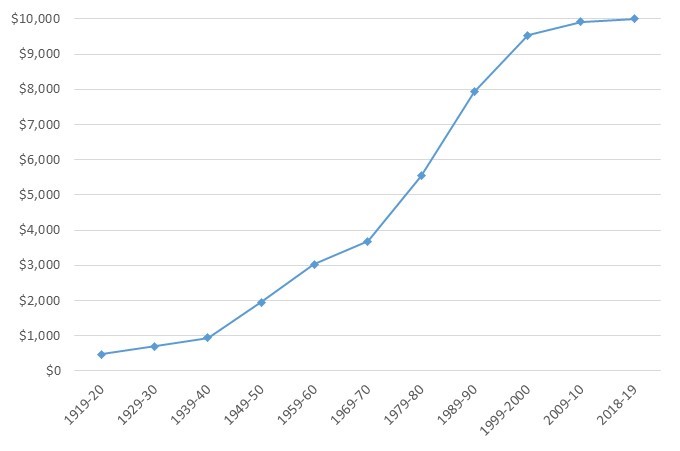Well, it’s not quite a record, but it’s close. Last school year (2018-19), per-pupil spending on public education in Oklahoma reached $10,000 (rounded by $4 and adjusted to 2015 dollars), only a little behind the zenith reached ten years earlier. That year (2008-2009), the federal government threw money at banks and states in an effort to reverse the beginning of the Great Recession. Across the nation, public education was at first insulated from the recession’s effects while taxpayers suffered job and home losses. But now, despite a gradual decline in public education funding for several years, Oklahoma’s public education spending has speedily and fully recovered, and then some.
For several years, per-pupil spending in Oklahoma public schools fell to levels last seen in the 1990s. But then, two years ago, Oklahoma’s legislators apparently resolved to show they could spend as freely as any before them. Funding had recovered almost to the level seen in 2000 (see the chart).
Average Per-Pupil Spending in Oklahoma Public Schools (2015 Dollars)

Sources: U.S. Census Bureau, Bureau of Labor Statistics, OK Dept of Education, author calculations
This year, we fully see the renewal of a trend nearly as old as public education itself, that even after accounting for inflation, per-pupil spending relentlessly increases from one decade to the next. Would that we could see a matching increase in performance.
For those of us who don’t assume spending money automatically means accomplishment, it is reassuring that thus far, it appears that the decade-over-decade inflation-adjusted spending per pupil will not increase as much as the decade before. In fact, the two decadal increases prior to this one, from 1990 to 2000 and from 2000 to 2010 both saw increases that were less than the decade before. This is a new trend, although the increase from 2019 appropriations is not reflected in the chart so far. In nearly 100 years of Oklahoma public education spending history gleaned from old editions of the Statistical Abstract of the United States (compiled by the Census Bureau) and Oklahoma state statistics, only the 1960s had previously not seen a bigger increase in per-pupil spending than a decade earlier.
During the 1980s and 1990s, there was a lot of emphasis nationally and in Oklahoma on equalizing funding in public education across school districts. Predictably, equalization was accomplished mostly by increasing spending in historically low-spending districts. Districts where spending had always been absurdly high didn’t see much in the way of reductions in spending, at least not in Oklahoma.
Today, one would be hard-pressed to find a child in Oklahoma experiencing anything close to an impoverished education. The teacher protests a few years ago had nothing to do with education, impoverished or otherwise. They had everything to do with maintaining the public schools as a jobs program for adults. If they were about education, then why are teachers never organized to fight the bureaucratic bloat in the public schools where every teacher position is matched by a non-teacher position? Teachers complain, but they’ve never been organized to protest the absurd lack of discipline foisted on their classrooms that teachers themselves identify as a barrier to learning. Where are the protests over discipline?
Best I can tell right now, there is no real effort by Oklahoma’s legislature to improve anything in public education, just an effort to curry its favor. That means spending money, and doing little else.
Byron Schlomach is Director of the 1889 Institute. He can be reached at [email protected].
The opinions expressed in this blog are those of the author, and do not necessarily reflect the official position of 1889 Institute.
